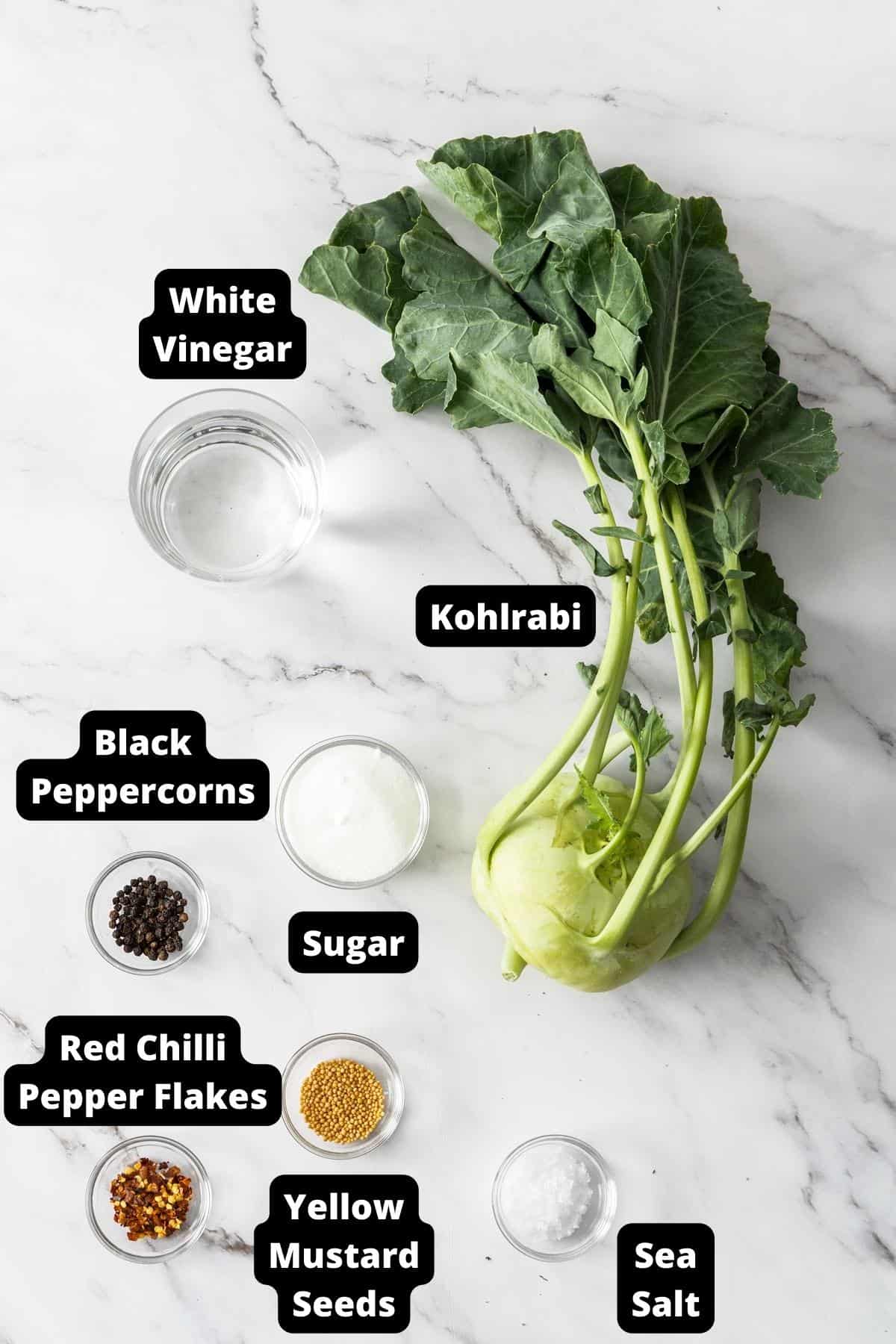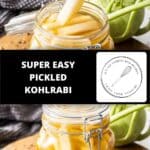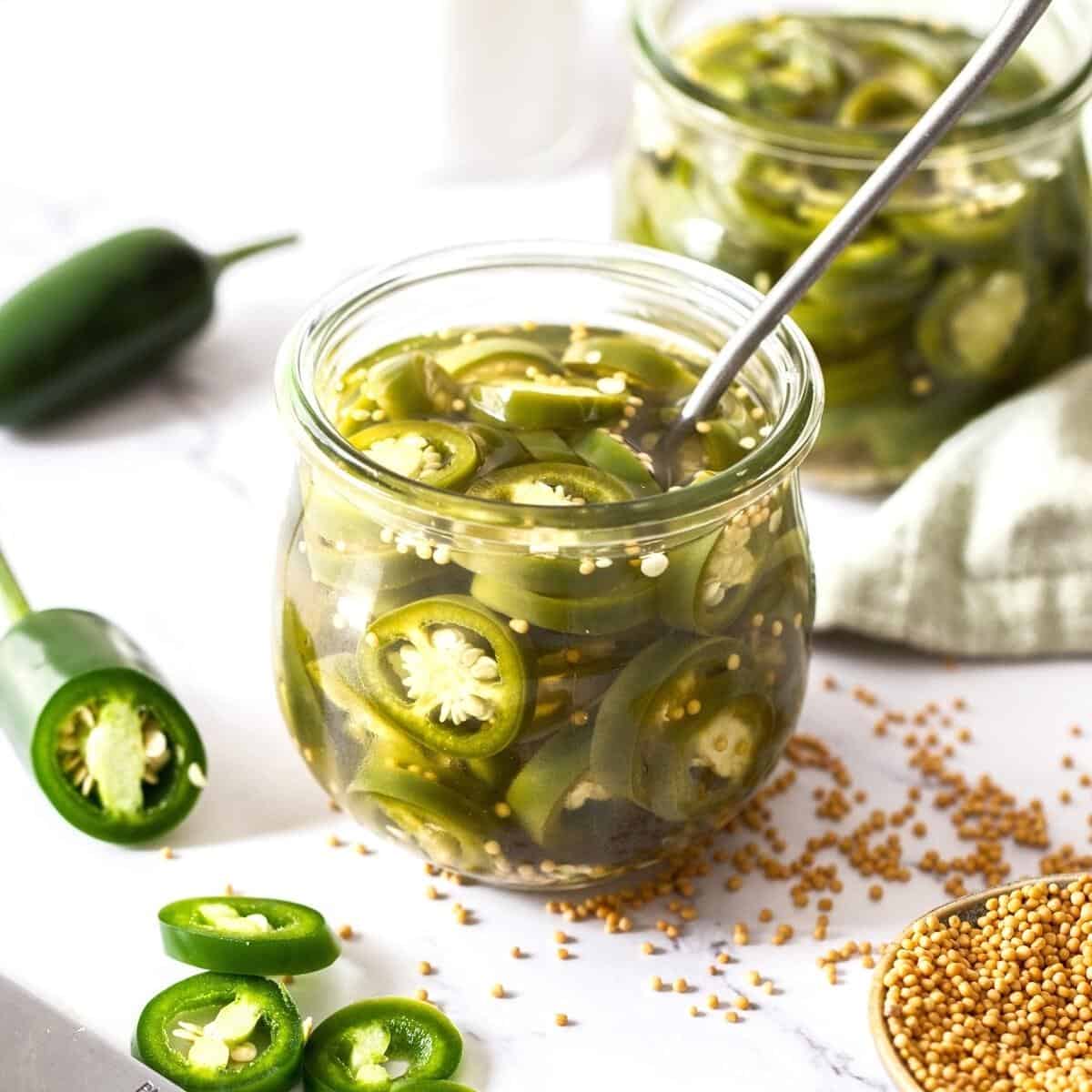If you enjoy the crunchy texture and bright flavour of a quick pickled vegetable, my Pickled Kohlrabi is for you. Tangy and crisp, this is a quick, easily made pickle that you will want to add to your repertoire. Small batons of kohlrabi are covered with a spiced vinegar brine. After a short wait, they are ready to enjoy. It doesn’t come much better or easier than that!

Why you’ll love this recipe:
A quick pickle can transform the flavour and texture of a vegetable and the crisp, mildly flavoured kohlrabi lends itself to this simple method as it maintains its crunchy texture.
These batons of Pickled Kohlrabi become an incredible flavour booster for so many dishes!
You will love this Pickled Kohlrabi because:
- Homemade pickles are quick to prepare and vibrant in flavour.
- When you make your own pickles, you know exactly what they contain and can adjust the flavours to your liking.
- Quick pickles are perfect for a novice or experienced cook alike. If you have not previously made your own pickles, this is a great place to start.
- There are many ways to enjoy this easy pickle; we have some ideas for you below.
What is kohlrabi?
Kohlrabi is also known as German turnip or cabbage turnip. Along with broccoli and kale, it is a member of the brassica family. There are several varieties, but we mainly see the green and purple kohlrabi in stores. However, they both have creamy white flesh.
When buying kohlrabi, avoid large bulbs as they tend to be woody. The bulb should be free of blemishes and feel firm. Avoid any with wilted leaves. The leaves are edible and can be used in a manner similar to other greens. It is best to remove the leaves and store them separately to the bulbs as they should be used within a few days.

Ingredients in this recipe:
Please see the recipe card further along in the post for exact quantities of ingredients and the full method.

Kohlrabi – for the best result, choose small to medium bulbs as large bulbs tend to be woody. The bulb should feel firm and be free of blemishes or cracks. If the leaves are attached, they are a good indicator of freshness. They should be bright green and perky.
White vinegar – for pickling, we use white vinegar with an acidity of 5%, but you can use white wine vinegar or apple cider vinegar if you prefer.
Water – for this quick pickle, we add a small amount of water to mellow the brine. Ensure you use filtered water, as water that contains chlorine can alter the taste of the pickles.
Salt – ensure you use sea salt, as regular table salt may contain anti-caking agents and is much stronger.
Sugar – regular granulated sugar works fine. It helps to preserve the pickles and balances the flavour. Caster/superfine sugar is also suitable to use.
Black peppercorns – contribute to the spicy flavour.
Mustard seeds – we use yellow mustard seeds to add crunch and flavour to the pickling brine.
Red chilli pepper flakes – a little heat works well with Pickled Kohlrabi. Add more to your liking if you wish.
How To Make Pickled Kohlrabi:
Please see the recipe card further along in the post for exact quantities of ingredients and the full method.

1 – Prepare the kohlrabi:
Trim the top and base of the kohlrabi and discard, then remove the skin.
2 – Cut the kohlrabi:
Cut the bulb in half and slice each half into 1 cm (⅖ inch) pieces. Then, cut each piece into 1cm (⅖ inch) strips.
Add the strips to a bowl of acidulated water to prevent browning. (details are in the recipe)

3 – Make the pickling liquid:
Add the ingredients for the pickle brine to a small saucepan. Stir over medium heat to dissolve sugar, then bring to the boil. Remove from heat.
4 – Add to your jar:
Add the kohlrabi to your jar, top with the pickling liquid and seal.
Allow to cool before refrigerating. It is best to let sit for a minimum of 12 hours for the flavours to develop.

Tips for success and FAQs:
For the best result for taste and texture, ensure your kohlrabi is nice and fresh.
When making your own pickles and preserves, always ensure the jars you use are properly sterilised. This is an important step but very simple to do. We include this information in the recipe. Also, I recommend that you use a jar with a wide opening to make it easier to fill with the kohlrabi.
When properly prepared and stored, the pickles will last in the fridge for up to 3 weeks. They will get softer the longer they sit.
You can, but it is best to resist the temptation and leave them for a minimum of 12 hours to let the flavours develop and the vinegar mellow.
They are somewhat like a mild radish and have a texture similar to a crunchy broccoli stem.
Absolutely – this recipe can be adapted to make a smaller or larger batch, depending on the quantity you require.
Variations and substitutions:
White vinegar – if you prefer, you can use white wine vinegar or apple cider vinegar.
Mustard seeds – we have used yellow mustard seeds, but you can use brown if you prefer. The yellow seeds are milder, and the brown spicier.

Serving suggestions:
You will find many ways to enjoy this easy Pickled Kohlrabi. Some of our favourite ways are:
- Add to a grazing platter.
- Serve alongside a hot dog or burger.
- To accompany a cheese selection.
- Add them to green salads for a crisp texture.
- They are a great addition to roast meats or poultry.
- Give a jar as a gift. You can even print out your own label, as seen in the photos! Simply right-click and save the image below to print out.

I hope you will love this simple, delicious recipe for Pickled Kohlrabi. Be sure to let me know in the comments below when you have tried them.
Alex xx
More delicious recipes for you to try:
Stay in touch!
Follow me on Facebook, Pinterest and Instagram and subscribe to my newsletter.

Pickled Kohlrabi
Equipment
- 1 x 800ml (27 fluid oz) Jar
Please note:
For accuracy, when weights are provided, we recommend weighing your ingredients. This will produce the best results. All oven temperatures listed are for fan forced.
Ingredients
- 400 g (14 oz) kohlrabi – prepared weight, approx. 1 large kohlrabi or 2 small. See Note 1
- 2 teaspoon sea salt See Note 2
- 1 cup (250 ml) white vinegar See Note 3
- ¾ cup (180 ml) water See Note 4
- 2 ½ tablespoon sugar See Note 5
- 1 teaspoon whole yellow mustard seeds
- 1 teaspoon whole black peppercorns
- ¼ teaspoon red chilli pepper flakes
- a bowl of water with lemon – optional See Note 6
Instructions
To Sterilise the Jars:
- Sterilise the jar or jars you'll be using to store the pickles. Choose glass jars with an airtight, metal lid and ensure they have been washed by hand in hot soapy water then rinsed well. Check that the metal lids do not have rubber inserts – if they do, allow them to air dry, instead of placing in the oven.Preheat the oven to 130 Degrees C (270 F) and place the jars in the oven for 15-20 minutes. Keep the jars warm.
For the Pickled Kohlrabi:
- Trim the top and base of the kohlrabi and discard. Set the leaves aside for another use.Peel the kohlrabi.
- Cut the kohlrabi in half and then slice into 1 cm pieces.Cut each piece into 1cm strips. Add the strips to the acidulated water to stop them from browning. (See Note 6.)
- In a small non-reactive saucepan, combine the water, vinegar, sugar and seasonings. Stir over medium heat to dissolve the sugar, bring to the boil and remove from the heat. (See Note 7).
- Add the kohlrabi to the sterilised jar, top with the pickling liquid and seal with the lid immediately.
- Allow the jar to cool on your bench before placing in the refrigerator.
- The Pickled Kohlrabi can be consumed once cool, but it is best to leave for 12-24 hours for the flavours to develop.
Notes
- Kohlrabi: ensure your kohlrabi is fresh and crisp.
- Cooking sea salt: ensure you use cooking salt or coarse sea salt. Regular table salt may contain anti-caking agents and is much stronger.
- Vinegar: I have used white vinegar that is 5% in acidity. You can also use apple cider or white wine vinegar – just ensure the acidity level is 5%.
- Water: ensure you use filtered water, as water that contains chlorine can alter the taste of the pickles.
- Tablespoon: we use a standard Australian tablespoon which is 20 ml (4 teaspoons).
- Acidulated water: to stop the kohlrabi from going brown, add a lemon cut in half to a bowl of water. Add the pieces of kohlrabi to the bowl as you cut them.
- Non-reactive saucepans: are those which are ceramic, stainless steel, glass or enamelled cookware. Copper, iron and aluminium pans are reactive. Acidic foods, such as vinegar or lemons, may take on a metallic taste and discolour if cooked in such pans.
- Storage: once the jars have cooled, store the pickles in the fridge for up to three weeks. This is a quick pickle recipe not designed for long term canning.
- Nutritional information: is based on the entire jar, and includes the pickling liquid.
Nutrition Estimate:
Nutritional Disclaimer:
The nutritional information is an estimate only, and is derived from online calculators. For accurate results, we recommend calculating the nutritional information based on the ingredients and brands you use.















Conchetta P
What a great add to my Charcuterie Board. So gourmet, so easy. My guests loved it-great recipe
Alexandra Cook
Hello Conchetta,
I am so happy you came across this recipe and that you and your guests enjoyed it 🙂
Thank you for taking the time to let me know! Alex xo